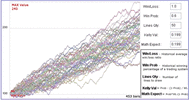We often hear about the importance of diversifying, but perhaps it's easier said than done. How much money do we put in each currency pair? When do we buy or sell those pairs? These are all questions that can be answered by defining a money management system. Here we look at the Kelly Criterion, one of the many techniques that can be used to manage your money effectively.
The History
John Kelly, who worked for AT&T's Bell Laboratory, originally developed the Kelly Criterion to assist AT&T with its long distance telephone signal noise issues. Soon after the method was published as "A New Interpretation Of Information Rate" (1956), however, the gambling community got wind of it and realized its potential as an optimal betting system in horse racing. It enabled gamblers to maximize the size of their bankroll over the long term. Now the system is used by many as a general money management system in not only gambling but also investing.
The Basics
There are two basic components to the Kelly Criterion:
• Win probability - The probability that any given trade you make will return a positive amount.
• Win/loss ratio - The total positive trade amounts divided by the total negative trade amounts.
These two factors are then put into Kelly's equation:
Kelly % = W – [(1 – W) / R]
Where:
W = Winning probability
R = Win/loss ratio
The output is the Kelly percentage, which we examine below.
Putting It to Use
Kelly's system can be put to use by following these simple steps:
Access your last 50-60 trades. You can do this by simply asking your broker, or by checking your recent tax returns (if you claimed all your trades). If you are a more advanced trader with a developed trading system, then you can simply back test the system and take those results. The Kelly Criterion assumes, however, that you trade the same way you traded in the past.
Calculate "W", the winning probability. To do this, divide the number of trades that returned a positive amount by your total number of trades (positive and negative). This number is better as it gets closer to one. Any number above 0.50 is good.
Calculate "R," the win/loss ratio. Do this by dividing the average gain of the positive trades by the average loss of the negative trades. You should have a number greater than 1 if your average gains are greater than your average losses. A result less than one is managable as long as the number of losing trades remains small.
Input these numbers into Kelly's equation: K% = W – [(1 – W) / R].
Record the Kelly % that the equation returns.
Interpreting the Results
The percentage (a number less than one) that the equation produces represents the size of the positions you should be taking. For example, if the Kelly percentage is 0.05, then you should take a 5% position in each of the equities in your portfolio. This system, in essence, lets you know how much you should diversify.
The system does require some common sense, however. One rule to keep in mind, regardless of what the Kelly percentage may tell you, is to never commit more than 10-20% of your capital to one currency pair. Allocating any more than this is carries far more risk than most people should be taking.
Is It Effective?
This system is based on pure mathematics. However, some people may question whether this math originally developed for telephones is actually effective in the Forex market or gambling arenas.
By showing the simulated growth of a given account based on pure mathematics, an equity chart can demonstrate the effectiveness of this system. In other words, the two variables must be entered correctly, and it must be assumed that the investor is able to maintain such performance. Here is an example:
((please refer to attachment))
Here we see the activity in 50 simulated trading accounts by means of an equity curve. The average amount won is the same as the average amount lost; however, the people are able to win 60% of the time. The Kelly Criterion then tells them to allocate 19% of their capital to each equity (giving them about five equities). The result is a positive return in the long run for all traders (notice some short-term downside, however). The highest return was 140% (started at 100, went to 240) over 453 bars. Bars represent the time between trades or trading system outputs.
Why Isn't Everyone Making Money?
No money management system is perfect. This system will help you to diversify your portfolio efficiently, but there are many things it can't do. It can't pick winning forex pairs for you, make sure you continue to trade consistently or predict sudden market changes (although it can lighten the blow).
Also, there is always a certain amount of "luck" or randomness in the markets, which can alter your returns. Consider again the chart we looked at above. See how the best person received a 140% return, the worst got less than 40%. Both traders used the same system, but randomness and volatility can cause temporary swings in account value.
Conclusion
Money management cannot ensure that you always make spectacular returns, but it can help you limit your losses and maximize your gains through efficient diversification. The Kelly Criterion is one of many models that can be used to help you diversify.
